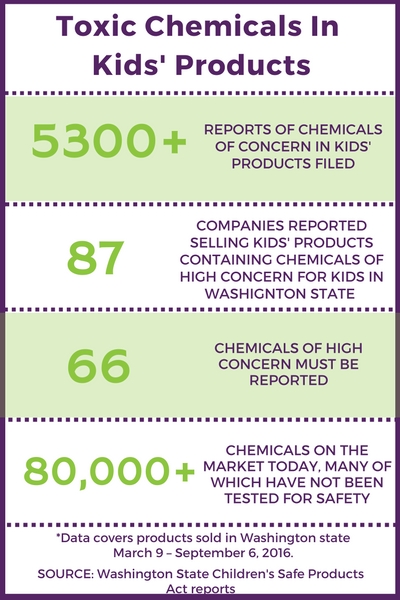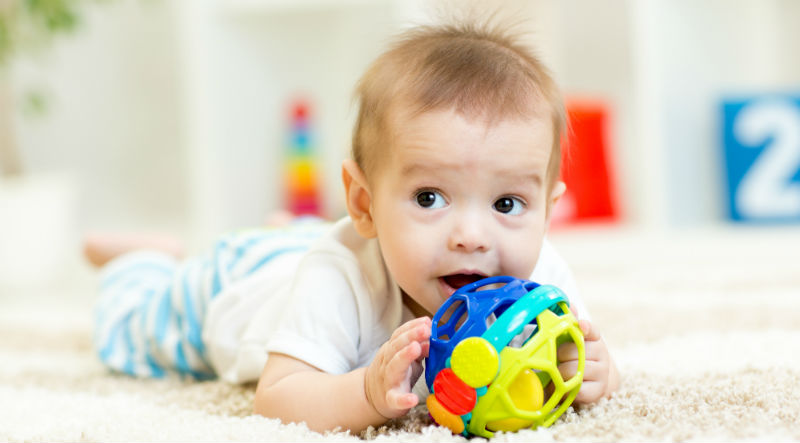It’s that time of year again when makers of children’s products must disclose to the public if their products contain chemicals that aren’t good for kids health.
We analyzed the data from this recent round of reports. The news isn’t great: kids’ products sold in Washington state still contain far too many toxic chemicals.
Makers of kids’ products filed over 5300 reports* that show their products sold in the state contain chemicals that are a concern for kids’ health. The chemicals include:
- Toxic flame retardants reported by 16 companies, including Michaels’ Stores (bedding and doll furniture), Target (toy vehicles), and MGA Little Tikes (outdoor play equipment).
- Hormone-disrupting phthalates reported by 31 companies, including GAP (sweaters), and Claire’s (gloves).
- Cancer-causing formaldehyde, reported by 20 companies, including Build-A-Bear Workshop (soft toys) and Cost Plus World Markets (dishware).
Most Chemicals Are Legal In Kids’ Products
Very few laws regulate the presence of toxic chemicals in kids’ products. That means most of the products reported are legal. However, at least two product makers may be violating state and/or federal law.
 Two manufacturers – MGA Little Tikes and Dollar Tree (Greenbrier International) – may be violating a state law that limits cadmium in kids’ toys to 40 ppm. Cadmium can remain in the body for a very long time and can harm developing brains and bodies.
Two manufacturers – MGA Little Tikes and Dollar Tree (Greenbrier International) – may be violating a state law that limits cadmium in kids’ toys to 40 ppm. Cadmium can remain in the body for a very long time and can harm developing brains and bodies.
- MGA Little Tikes reports cadmium at between 100 ppm and 500 ppm in nonmotorized ride-on toys.
- Dollar Tree (Greenbrier International) reports cadmium in textiles of toys and games variety pack.
Dollar Tree may also have sold products that exceeded federal limits for the phthalate DEHP, a chemical that is linked to hormone disruption. The company reported over 1,000 ppm DEHP in toys and games variety packs. The federal limit is 1,000 ppm.
The reports should prompt state and federal agencies to investigate, and if warranted, take action against companies exceeding state limits for cadmium and federal limits for phthalates.
It’s Not ALL Bad News
There are some bright spots in the latest round of reports.
The GAP, a company that has said in the past it is paying attention to Washington’s reporting law and reevaluating it’s use of chemicals of concern for children in products, did not report nearly as many products as in past years. Could this decrease mean they aren’t using as many chemicals? Only time will tell if this trend holds up.
Also, thanks to the new Toxic-Free Kids and Families Act, which passed earlier this year and bans several toxic flame retardants in kids’ products and home furniture, next year’s reports shouldn’t include products with these harmful chemicals in them.
We recently asked Ecology to consider adding several additional chemicals to list of chemicals product makers must report. These chemicals include additional flame retardants, stain resistors, and plasticizers (they make plastic soft).
Ecology responded and announced they will consider requiring reporting of several of these chemicals.
So What Should Consumers Do?
Unfortunately, until companies and policymakers take actions to remove harmful chemicals from children’s products, consumers have to take the initiative to protect themselves and their families. Here are a few recommendations:
- Tell companies and policymakers that you don’t want harmful chemicals in consumer products! Check out ways to make your voice heard on our take action center and sign up for our email alerts to keep in the loop on the latest ways to stay involved.
- Follow our Healthy Living tips for finding safer toys and other children’s products.
*Reports filed cover products sold in Washington state March 9 – September 6, 2016.




